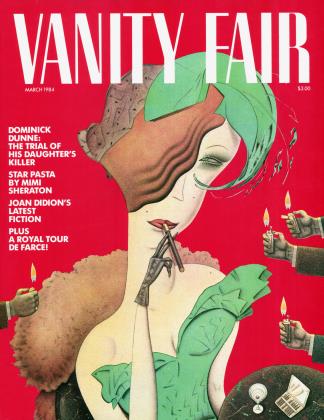Sign In to Your Account
Subscribers have complete access to the archive.
Sign In Not a Subscriber?Join NowARCHITECTURE
LIMELIGHT, NEW YORK, Ari Bahat, architect for the renovation. When Limelight discotheque opened this fall in a deconsecrated Episcopal church in Manhattan, the Right Reverend Paul Moore, Jr. (the Episcopal bishop of New York), was quoted as saying, "We are horrified." It was not the secular activities per se that repelled him, "but using religion in a kinky way is in such bad taste."
For those who dread the thought of Black Masses with light shows or unrobed altar boys swinging hashish in gold censers to the heavy-metal sounds of Judas Priest, inspection will bring relief. Basically the church facade is intact—for the Gothic Revival building, designed by Richard Upjohn in the years 1844-46, has landmark status. Chunks of the interior also remain and have been refurbished. True, signs of sacrilege can be spotted: carved paneling from wainscoting and pews has been used for bars and lounge furnishings; an ornamented pulpit overlooks a dance floor crammed with writhing heathens. But generally the liturgical presence has been overwhelmed by a Skylab scaffold of steel framing, with balconies and catwalks, chromed light pillars, twirling neon tubes, and klieg lights, all of which transmogrifies the church into a flashy, pulsating dance palace. The assemblage is so much of a piece that it seems as if it could be removed from the arched Gothic shell (in fact the architect, Ari Bahat, designed it to be freestanding) and reinstalled at the Paramus, New Jersey, shopping mall, without anyone noticing—or missing a beat.
To be sure the new innards are not tasteful, as Reverend Moore complained. Actually they range from cute to trashy. But if any punishment for the sin of tastelessness is meted out, it should be based on aesthetic grounds rather than religious ones. The Episcopalian reaction to Limelight might be considered ironic to those familiar with the ordained fate of another Episcopalian landmark in New York, Saint Bartholomew's Church on Park Avenue. There Reverend Moore and the church fathers have approved the construction of a large glassy office building that will loom right over Bertram Goodhue's remarkable Byzantine-style structure built in 1919. At least Limelight's "tasteless" commercialism is kept concealed behind its brownstone walls.
SUZANNE STEPHENS
V.F. RECOMMENDS
Books
THE AMSTERDAM SCHOOL: DUTCH EXPRESSIONIST ARCHITECTURE, 1915-1930
edited by Wim de Wit (The Cooper-Hewitt Museum and MIT Press).
GAUDI Ignasi de Sola-Morales (Rizzoli/New York).
FRANK LLOYD WRIGHT AND THE PRAIRIE SCHOOL H. Allen Brooks (Braziller).
REDESIGNING THE AMERICAN DREAM: THE FUTURE OF HOUSING, WORK, AND FAMILY LIFE
Dolores Hayden (W. W. Norton).
Exhibits
CHICAGO AND NEW YORK: MORE THAN A CENTURY OF ARCHITECTURAL INTERACTION Art Institute of Chicago, March 8—July 29.
PARIS-ROME-ATH ENS: DRAWINGS OF CLASSICAL GREEK ARCHITECTURE FROM THE ECOLE DES BEAUX-ARTS
IBM Gallery of Science and Art, New York, to March 24.
Symposium
THE ARCHITECTURE AND INFLUENCE OF SIR JOHN SOANE, 1753-1837 The Cooper-Hewitt Museum, New York, March 3,10 A.M.-4 P.M.
 View Full Issue
View Full Issue












Subscribers have complete access to the archive.
Sign In Not a Subscriber?Join Now